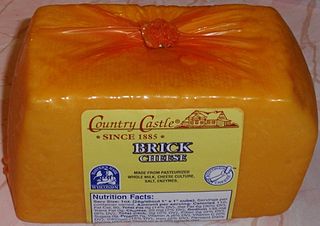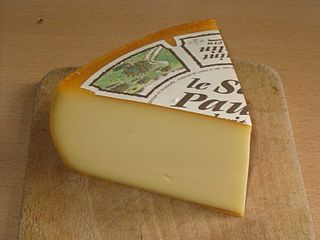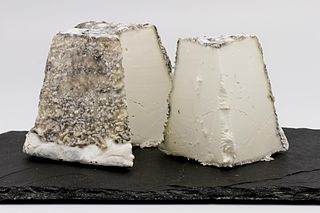
Hungarian or Magyar cuisine is the cuisine characteristic of the nation of Hungary and its primary ethnic group, the Magyars. Traditional Hungarian dishes are primarily based on meats, seasonal vegetables, fruits, bread, and dairy products.

Monterey Jack, sometimes shortened to Jack, is a US white, semi-hard cheese made using cow's milk, with a mild flavor and slight sweetness. It has been called "an American original" and "as a vestige of Spanish rule in the early nineteenth century, derives from a Franciscan monastic style of farmer's cheese."

A crouton is a piece of rebaked bread, often cubed and seasoned. Croutons are used to add texture and flavor to salads—notably the Caesar salad— or eaten as a snack food.

Goat cheese, goat's cheese, or chèvre, is cheese made from goat's milk. Goats were among the first animals to be domesticated for producing food. Goat cheese is made around the world with a variety of recipes, giving many different styles of cheese, from fresh and soft to aged and hard.

Bel Paese is a semi-soft Italian cheese. It was invented in 1906 by Egidio Galbani who wanted to produce a mild and delicate cheese to sell mainly in Italy. The name Bel Paese comes from the title of a book written by Antonio Stoppani. It is Italian for "beautiful country", and is used as a phrase for Italy itself.
Havarti or cream havarti is a semisoft Danish cow's milk cheese. It can be sliced, grilled, or melted.

Wine and food matching is the process of pairing food dishes with wine to enhance the dining experience. In many cultures, wine has had a long history of being a staple at the dinner table and in some ways both the winemaking and culinary traditions of a region will have evolved together over the years. Rather than following a set of rules, local cuisines were paired simply with local wines. The modern "art" of food pairings is a relatively recent phenomenon, fostering an industry of books and media with guidelines for pairings of particular foods and wine. In the restaurant industry, sommeliers are often present to make food pairing recommendations for the guest. The main concept behind pairings is that certain elements in both food and wine interact with each other, and thus finding the right combination of these elements will make the entire dining experience more enjoyable. However, taste and enjoyment are very subjective and what may be a "textbook perfect" pairing for one taster could be less enjoyable to another.

Burrata is an Italian cow milk cheese made from mozzarella and cream. The outer casing is solid cheese, while the inside contains stracciatella and cream, giving it an unusual, soft texture. It is typical of Puglia.

Brick cheese is a cheese from Wisconsin, U.S., made in brick-shaped form. The color ranges from pale yellow to white, and the cheese has a sweet and mild flavor when young, and matures into a strong, ripe cheese with age. It is a medium-soft cheese.

Muenster or munster is a semi-soft cheese from the United States. It is thought to be an imitation of the Alsatian washed-rind Munster cheese, introduced by German immigrants. It is distinct from the processed dairy food Sweet Muenster Cheese. Its name is not related to the German cities of Münster in Westphalia or in Lower Saxony or the Irish province of Munster, but rather to the city of Munster in Alsace, which was part of Germany at the time the cheese was introduced in the US by German immigrants, but is now in France.

Saint Paulin is a creamy, mild, semi-soft French cheese made from pasteurized cow's milk, originally made by Trappist monks at Saint Paulin. It is a buttery cheese, but firm enough for slicing. Saint Paulin is similar to Havarti and Esrom, and is suited to serving as a table or dessert cheese; it is often served with fruit and light wine. Genuine Saint Paulin has an edible yellow-orange rind. It is ripened in a round loaf with slightly protruding sides, and matures in about four weeks.

Castello is a brand of cheeses produced by Arla Foods amba, a Danish agricultural marketing cooperative based in Viby, Aarhus. Worldwide, a variety of cheeses are marketed under the Castello name, including semi soft cheeses, semi hard cheeses, blue cheeses, and cream cheeses.
Parrano cheese is a cow milk cheese produced in the Netherlands. It tastes mild and nutty, combining salty and sweet flavours. It has a semi-firm texture and a smooth, golden coloured paste. Made from pasteurized milk, Parrano is produced in 20 lb (9.1 kg) wheels and is aged for 5 months.

There are many different types of cheese. Cheeses can be grouped or classified according to criteria such as length of fermentation, texture, methods of production, fat content, animal milk, and country or region of origin. The method most commonly and traditionally used is based on moisture content, which is then further narrowed down by fat content and curing or ripening methods. The criteria may either be used singly or in combination, with no single method being universally used.

Beninese cuisine involves many fresh meals served with a variety of sauces. Meat is usually quite expensive, and meals are generally light on meat and generous on vegetable fat.

Limburger is a cheese that originated in the Herve area of the historical Duchy of Limburg, which had its capital in Limbourg-sur-Vesdre, now in the French-speaking Belgian province of Liège. The cheese is especially known for its strong smell caused by the bacterium Brevibacterium linens.














